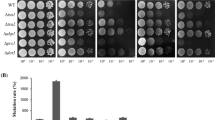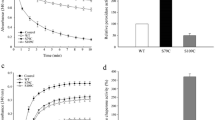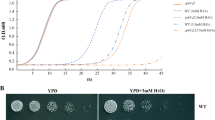Abstract
Cyclophilins are conserved cis–trans peptidyl-prolyl isomerase that are implicated in protein folding and function as molecular chaperones. The accumulation of Cpr1 protein to menadione in Saccharomyces cerevisiae KNU5377Y suggests a possibility that this protein may participate in the mechanism of stress tolerance. Stress response of S. cerevisiae KNU5377Y cpr1Δ mutant strain was investigated in the presence of menadione (MD). The growth ability of the strain was confirmed in an oxidant-supplemented medium, and a relationship was established between diminishing levels of cell rescue enzymes and MD sensitivity. The results demonstrate the significant effect of CPR1 disruption in the cellular growth rate, cell viability and morphology, and redox state in the presence of MD and suggest the possible role of Cpr1p in acquiring sensitivity to MD and its physiological role in cellular stress tolerance. The in vivo importance of Cpr1p for antioxidant-mediated reactive oxygen species (ROS) neutralization and chaperone-mediated protein folding was confirmed by analyzing the expression changes of a variety of cell rescue proteins in a CPR1-disrupted strain. The cpr1Δ to the exogenous MD showed reduced expression level of antioxidant enzymes, molecular chaperones, and metabolic enzymes such as nicotinamide adenine dinucleotide phosphate (NADPH)- or adenosine triphosphate (ATP)-generating systems. More importantly, it was shown that cpr1Δ mutant caused imbalance in the cellular redox homeostasis and increased ROS levels in the cytosol as well as mitochondria and elevated iron concentrations. As a result of excess ROS production, the cpr1Δ mutant provoked an increase in oxidative damage and a reduction in antioxidant activity and free radical scavenger ability. However, there was no difference in the stress responses between the wild-type and the cpr1Δ mutant strains derived from S. cerevisiae BY4741 as a control strain under the same stress. Unlike BY4741, KNU5377Y Cpr1 protein was decarbonylated during MD stress. Decarbonylation of Cpr1 protein in KNU5377Y strain seems to be caused by a rapid and efficient gene expression program via stress response factors Hsf1, Yap1, and Msn2. Hence, the decarbonylated Cpr1 protein may be critical in cellular redox homeostasis and may be a potential chaperone to menadione.






Similar content being viewed by others
References
Ansari H, Greco G, Luban J (2002) Cyclophilin A peptidyl-prolyl isomerase activity promotes ZPR1 nuclear export. Mol Cell Biol 22:6993–7003
Arevalo-Rodriguez M, Heitman J (2005) Cyclophilin A is localized to the nucleus and controls meiosis in Saccharomyces cerevisiae. Eukaryot Cell 4:17–29
Arevalo-Rodriguez M, Cardenas ME, Wu X, Hanes SD, Heitman J (2000) Cyclophilin A and Ess1 interact with and regulate silencing by the Sin3-Rpd3 histone deacetylase. EMBO J 19:3739–3749
Arevalo-Rodriguez M, Wu X, Hanes SD, Heitman J (2004) Prolyl isomerases in yeast. Front Biosci 9:2420–2446
Babcock M, de Silva D, Oaks R, Davis-Kaplan S, Jiralerspong S, Montermini L, Pandolfo M, Kaplan J (1997) Regulation of mitochondrial iron accumulation by Yfh1p, a putative homolog of frataxin. Science 276:1709–1712
Bernier-Villamor LNE, Sevilla F, Lázaro JJ (2004) Cloning and characterization of a 2-Cys peroxiredoxin from Pisum sativum. J Exp Bot 55:2191–2199
Cashikar AG, Duennwald M, Lindquist SL (2005) A chaperone pathway in protein disaggregation. Hsp26 alters the nature of protein aggregates to facilitate reactivation by Hsp104. J Biol Chem 280:23869–23875
Castro FA, Herdeiro RS, Panek AD, Eleutherio EC, Pereira MD (2007) Menadione stress in Saccharomyces cerevisiae strains deficient in the glutathione transferases. Biochim Biophys Acta 1770:213–220
Causton HC, Ren B, Koh SS, Harbison CT, Kanin E, Jennings EG, Lee TI, True HL, Lander ES, Young RA (2001) Remodeling of yeast genome expression in response to environmental changes. Mol Biol Cell 12:323–337
Chen AP, Wang GL, Qu ZL, Lu CX, Liu N, Wang F, Xia GX (2007) Ectopic expression of ThCYP1, a stress-responsive cyclophilin gene from Thellungiella halophila, confers salt tolerance in fission yeast and tobacco cells. Plant Cell Rep 26:237–245
Chen H, Qu Z, Fu L, Dong P, Zhang X (2009) Physicochemical properties and antioxidant capacity of 3 polysaccharides from green tea, oolong tea, and black tea. J Food Sci 74:C469–C474
Chu F, Maynard JC, Chiosis G, Nicchitta CV, Burlingame AL (2006) Identification of novel quaternary domain interactions in the Hsp90 chaperone, GRP94. Protein Sci 15:1260–1269
Coaker G, Falick A, Staskawicz B (2005) Activation of a phytopathogenic bacterial effector protein by a eukaryotic cyclophilin. Science 308:548–550
Costa VM, Amorim MA, Quintanilha A, Moradas-Ferreira P (2002) Hydrogen peroxide-induced carbonylation of key metabolic enzymes in Saccharomyces cerevisiae: the involvement of the oxidative stress response regulators Yap1 and Skn7. Free Radic Biol Med 33:1507–1515
Costa V, Quintanilha A, Moradas-Ferreira P (2007) Protein oxidation, repair mechanisms and proteolysis in Saccharomyces cerevisiae. IUBMB Life 59:293–298
Demasi AP, Pereira GA, Netto LE (2006) Yeast oxidative stress response. Influences of cytosolic thioredoxin peroxidase I and of the mitochondrial functional state. FEBS J 273:805–816
Dominguez-Solis JR, He Z, Lima A, Ting J, Buchanan BB, Luan S (2008) A cyclophilin links redox and light signals to cysteine biosynthesis and stress responses in chloroplasts. Proc Natl Acad Sci USA 105:16386–16391
Doyle V, Virji S, Crompton M (1999) Evidence that cyclophilin-A protects cells against oxidative stress. Biochem J 341:127–132
Fernandes PN, Mannarino SC, Silva CG, Pereira MD, Panek AD, Eleutherio EC (2007) Oxidative stress response in eukaryotes: effect of glutathione, superoxide dismutase and catalase on adaptation to peroxide and menadione stresses in Saccharomyces cerevisiae. Redox Rep 12:236–244
Galat A (2004) Function-dependent clustering of orthologues and paralogues of cyclophilins. Proteins 56:808–820
Gasch AP, Spellman PT, Kao CM, Carmel-Harel O, Eisen MB, Storz G, Botstein D, Brown PO (2000) Genomic expression programs in the response of yeast cells to environmental changes. Mol Biol Cell 11:4241–4257
Gay C, Collins J, Gebicki JM (1999) Hydroperoxide assay with the ferric-xylenol orange complex. Anal Biochem 273:149–155
Ghezzi P, Casagrande S, Massignan T, Basso M, Bellacchio E, Mollica L, Biasini E, Tonelli R, Eberini I, Gianazza E (2006) Redox regulation of cyclophilin A by glutathionylation. Proteomics 6:817–825
Gillespie KM, Chae JM, Ainsworth EA (2007) Rapid measurement of total antioxidant capacity in plants. Nat Protoc 2:867–870
Gong Y, Kakihara Y, Krogan N, Greenblatt J, Emili A, Zhang Z, Houry WA (2009) An atlas of chaperone-protein interactions in Saccharomyces cerevisiae: implications to protein folding pathways in the cell. Mol Syst Biol 5:275
Han D, Antunes F, Canali R, Rettori D, Cadenas E (2003) Voltage-dependent anion channels control the release of the superoxide anion from mitochondria to cytosol. J Biol Chem 278:5557–5563
Hartl FU, Hayer-Hartl M (2002) Molecular chaperones in the cytosol: from nascent chain to folded protein. Science 295:1852–1858
Haslbeck M, Miess A, Stromer T, Walter S, Buchner J (2005) Disassembling protein aggregates in the yeast cytosol. The cooperation of Hsp26 with Ssa1 and Hsp104. J Biol Chem 280:23861–23868
Herrero E, Ros J, Belli G, Cabiscol E (2008) Redox control and oxidative stress in yeast cells. Biochim Biophys Acta 1780:1217–1235
Imai J, Yahara I (2000) Role of HSP90 in salt stress tolerance via stabilization and regulation of calcineurin. Mol Cell Biol 20:9262–9270
Jamieson DJ (1998) Oxidative stress responses of the yeast Saccharomyces cerevisiae. Yeast 14:1511–1527
Jaschke A, Mi H, Tropschug M (1998) Human T cell cyclophilin18 binds to thiol-specific antioxidant protein Aop1 and stimulates its activity. J Mol Biol 277:763–769
Kim IS, Yun HS, Yun IH, Jin I (2006a) Genome-wide expression analyses of adaptive response against menadione-induced oxidative stress in Saccharomyces cerevisiae KNU5377. Process Biochem 41:2305–2313
Kim IS, Yun HS, Park IS, Sohn HY, Iwahashi H, Jin IN (2006b) A knockout strain of CPR1 induced during fermentation of Saccharomyces cerevisiae KNU5377 is susceptible to various types of stress. J Biosci Bioeng 102:288–296
Kim IS, Kim HY, Shin SY, Kim YS, Yoon HS (2010a) A cyclophilin A CPR1 overexpression enhances stress acquisition in Saccharomyces cerevisiae. Mol Cells 29:567–574
Kim JH, Sedlak M, Gao Q, Riley CP, Regnier FE, Adamec J (2010b) Oxidative stress studies in yeast with a frataxin mutant: a proteomics perspective. J Proteome Res 9:730–736
Kruszewski M (2003) Labile iron pool: the main determinant of cellular response to oxidative stress. Mutat Res 531:81–92
Lee SP, Hwang YS, Kim YJ, Kwon KS, Kim HJ, Kim K, Chae HZ (2001) Cyclophilin a binds to peroxiredoxins and activates its peroxidase activity. J Biol Chem 276:29826–29832
Lee SJ, Yang ES, Kim SY, Kim SY, Shin SW, Park JW (2008) Regulation of heat shock-induced apoptosis by sensitive to apoptosis gene protein. Free Radic Biol Med 45:167–176
Massignan T, Casoni F, Basso M, Stefanazzi P, Biasini E, Tortarolo M, Salmona M, Gianazza E, Bendotti C, Bonetto V (2007) Proteomic analysis of spinal cord of presymptomatic amyotrophic lateral sclerosis G93A SOD1 mouse. Biochem Biophys Res Commun 353:719–725
Mayr C, Richter K, Lilie H, Buchner J (2000) Cpr6 and Cpr7, two closely related Hsp90-associated immunophilins from Saccharomyces cerevisiae, differ in their functional properties. J Biol Chem 275:34140–34146
Mishra AK, Gangwani L, Davis RJ, Lambright DG (2007) Structural insights into the interaction of the evolutionarily conserved ZPR1 domain tandem with eukaryotic EF1A, receptors, and SMN complexes. Proc Natl Acad Sci USA 104:13930–13935
Moradas-Ferreira P, Costa V (2000) Adaptive response of the yeast Saccharomyces cerevisiae to reactive oxygen species: defences, damage and death. Redox Rep 5:277–285
Motohashi K, Koyama F, Nakanishi Y, Ueoka-Nakanishi H, Hisabori T (2003) Chloroplast cyclophilin is a target protein of thioredoxin. Thiol modulation of the peptidyl-prolyl cis–trans isomerase activity. J Biol Chem 278:31848–31852
Perez S, Weis V (2008) Cyclophilin and the regulation of symbiosis in Aiptasia pallida. Biol Bull 215:63–72
Piotukh K, Gu W, Kofler M, Labudde D, Helms V, Freund C (2005) Cyclophilin A binds to linear peptide motifs containing a consensus that is present in many human proteins. J Biol Chem 280:23668–23674
Raitt DC, Johnson AL, Erkine AM, Makino K, Morgan B, Gross DS, Johnston LH (2000) The Skn7 response regulator of Saccharomyces cerevisiae interacts with Hsf1 in vivo and is required for the induction of heat shock genes by oxidative stress. Mol Biol Cell 11:2335–2347
Reddy PA, Atreya CD (1999) Identification of simian cyclophilin A as a calreticulin-binding protein in yeast two-hybrid screen and demonstration of cyclophilin A interaction with calreticulin. Int J Biol Macromol 25:345–351
Romano PG, Horton P, Gray JE (2004) The Arabidopsis cyclophilin gene family. Plant Physiol 134:1268–1282
Roy CN, Andrews NC (2001) Recent advances in disorders of iron metabolism: mutations, mechanisms and modifiers. Hum Mol Genet 10:2181–2186
Skoneczna A, Micialkiewicz A, Skoneczny M (2007) Saccharomyces cerevisiae Hsp31p, a stress response protein conferring protection against reactive oxygen species. Free Radic Biol Med 42:1409–1420
Sugiyama K, Izawa S, Inoue Y (2000) The Yap1p-dependent induction of glutathione synthesis in heat shock response of Saccharomyces cerevisiae. J Biol Chem 275:15535–15540
Tamarit J, Irazusta V, Moreno-Cermeno A, Ros J (2006) Colorimetric assay for the quantitation of iron in yeast. Anal Biochem 351:149–151
Tan SX, Teo M, Lam YT, Dawes IW, Perrone GG (2009) Cu, Zn superoxide dismutase and NADP(H) homeostasis are required for tolerance of endoplasmic reticulum stress in Saccharomyces cerevisiae. Mol Biol Cell 20:1493–1508
Tucker CL, Fields S (2004) Quantitative genome-wide analysis of yeast deletion strain sensitivities to oxidative and chemical stress. Comp Funct Genomics 5:216–224
Wang P, Heitman J (2005) The cyclophilins. Genome Biol 6:226
Wang P, Cardenas ME, Cox GM, Perfect JR, Heitman J (2001) Two cyclophilin A homologs with shared and distinct functions important for growth and virulence of Cryptococcus neoformans. EMBO Rep 2:511–518
Wegele H, Haslbeck M, Reinstein J, Buchner J (2003) Sti1 is a novel activator of the Ssa proteins. J Biol Chem 278:25970–25976
Wotton D, Freeman K, Shore D (1996) Multimerization of Hsp42p, a novel heat shock protein of Saccharomyces cerevisiae, is dependent on a conserved carboxyl-terminal sequence. J Biol Chem 271:2717–2723
Zhao R, Davey M, Hsu YC, Kaplanek P, Tong A, Parsons AB, Krogan N, Cagney G, Mai D, Greenblatt J (2005) Navigating the chaperone network: an integrative map of physical and genetic interactions mediated by the hsp90 chaperone. Cell 120:715–727
Acknowledgments
This research was supported by a grant (#2009-0072715) from the Basic Science Research Program through the National Research Foundation (NRF) of Korea funded by the Ministry of Education, Science and Technology and by a grant (20070301-034-021) from BioGreen 21 Program, Rural Development Administration.
Author information
Authors and Affiliations
Corresponding author
Electronic supplementary materials
Below is the link to the electronic supplementary material.
ESM 1
(DOC 24 kb)
Fig. S1
Antioxidant enzyme activity. Relative enzyme activity of glutathione reductase (GR) (a), glutathione peroxide (GPX) (b), glucose-6-phosphate dehydrogenase (G6PDH) (c), and isocitrate dehydrogenase (IDH) (d) was calculated (JPEG 187 kb)
Fig. S2
Cpr1 expression, stress sensitivity, and redox state analysis in hsp104 mutant from KNU5377Y. a Cpr1 expression was analyzed via immunoblotting analysis with anti-Cpr1 antibody. Tubulin (Tub) was used a standard control. N, untreated cells; S, 0.4 mM MD-treated cells. b Mid-log yeast cells were streaked onto YPD agar plate supplemented with 0.05 mM MD. WT, wild-type cells; hsp104Δ, hsp104 mutant cells. c Measurement of in vivo molecular oxidation. DCF (cytosol) fluorescences were measured in yeast cells, exposed to 0.4 mM MD for 1 h. Fluorescence images were obtained under microscopy; With, MD-treated cells; Without, MD-untreated cells (JPEG 115 kb)
Fig. S3
Transcriptional level, cell viability, and redox state of HSF1 under MD stress. a Transcriptional level of HSF1 was carried out with semi-RT-PCR from total RNA in wild-type (HSF1+/+) and hsf1 mutant (HSF1+/−) from diploid KNU5377Y and BY4743 (EUROSCARF). mRNA transcript of PDA1 was used as a housekeeping control. N, MD (0.4 mM)-untreated cells; S, MD-treated cells. b Mid-log phase cells were exposed to a variety of MD concentration (0.0–0.8 mM), serially diluted to 10−5, and then dispensed onto YPD agar plate. Cell viability was calculated as counting colony. Wild-type cells (HSF+/+) (filled square) and hsf1 mutant (HSF1+/−) cells (filled circle) from KNU5377Y3; wild-type cells (HSF+/+) (filled triangle) and hsf1 mutant (HSF1+/−) cells (filled inverted triangle) from BY4743. c Mid-log phase yeast cells were exposed to 0.4 mM MD for 1 h at 30°C with shaking (160 rpm). Cellular ROS levels were analyzed using light microscope with oxidant-sensitive probe DCFHDA as described in “Materials and methods”. (JPEG 77 kb)
Fig. S4
Growth rate under normal condition. Growth kinetics was measured at 600 nm using spectrophotometer. Initial optical density is adjusted to 0.1. kwt (filled square), kc1 (filled circle), bwt (filled triangle), and bc1 (filled inverted triangle) (JPEG 77 kb)
Fig. S5
Cell viability of S. cerevisiae BY4741 in the presence of MD. Yeast cells grown at 30°C for 18 h were inoculated in fresh YPD medium (initial optical density A600 = 0.15), cultured for about 5 h at 30°C until the absorbance reached a value of 1.2–1.5 and then exposed to MD for 1 h with shaking (160 rpm). Yeast cells with and without MD were serially diluted to 10–5 and 100 μl of the 10−5-diluted solutions was dispensed onto YPD agar plate. After 2 days of incubation, CFU was counted (a) and the plate was photographed (b). For spotting assay, 5 μl of diluted solutions was spotted onto YPD agar plate (c) (JPEG 151 kb)
Rights and permissions
About this article
Cite this article
Kim, IS., Jin, I. & Yoon, HS. Decarbonylated cyclophilin A Cpr1 protein protects Saccharomyces cerevisiae KNU5377Y when exposed to stress induced by menadione. Cell Stress and Chaperones 16, 1–14 (2011). https://doi.org/10.1007/s12192-010-0215-9
Received:
Revised:
Accepted:
Published:
Issue Date:
DOI: https://doi.org/10.1007/s12192-010-0215-9




